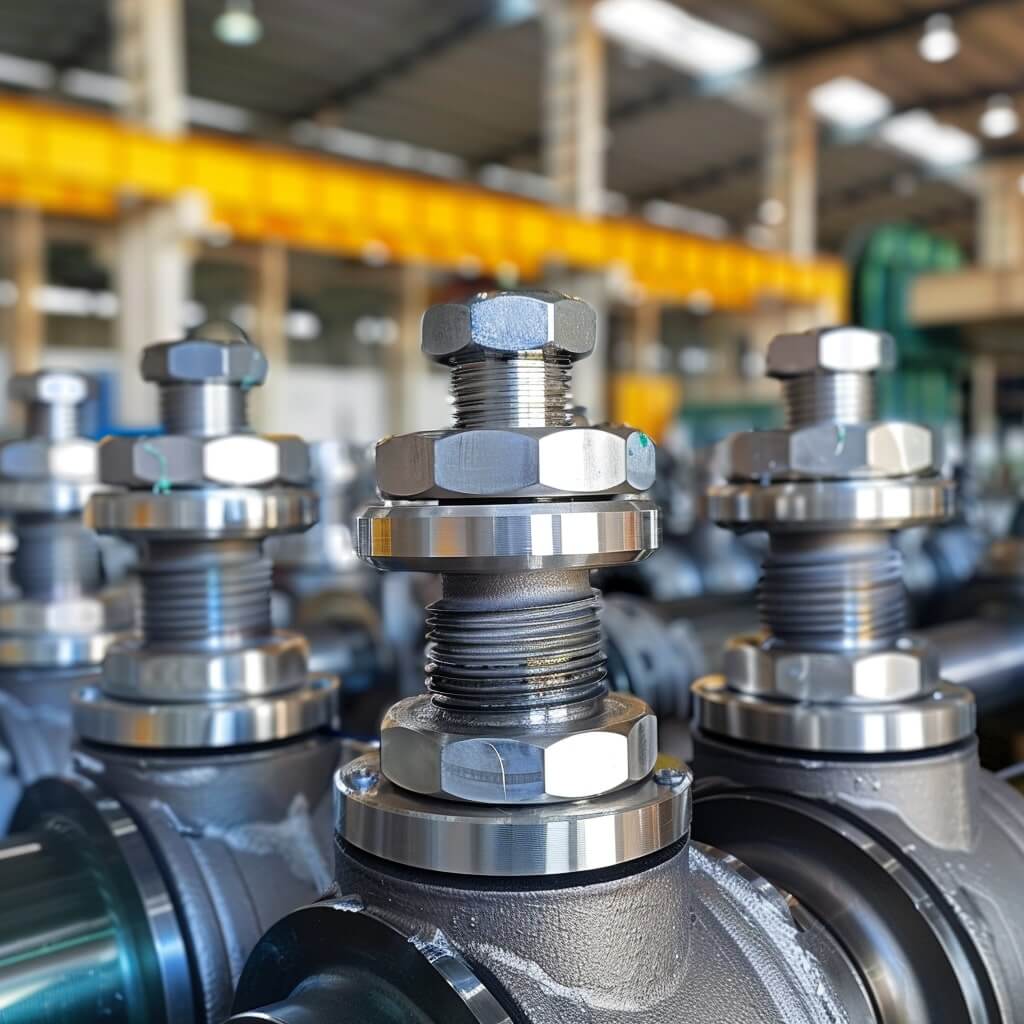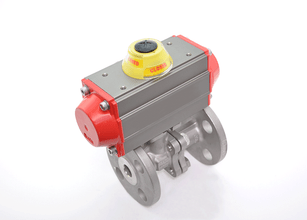Ball Valve Types and Applications
Posted by Mark Trainer on Apr 16th 2024
Ball valves are important components in a vast range of systems, from small family-owned workshops to huge industrial facilities - ball valves are everywhere. However, despite the widespread use of these clever little devices, many are unaware of the sheer range of ball valve types available.
Through this article, we hope to shed some light on the topic by explaining the main types of ball valves and highlighting the diverse range, focusing on specific features and applications.
Ball Valve Types
- Manual Ball Valves
- Electric Ball Valves
- Pneumatic Ball Valves
- Cryogenic Ball Valves
- High Pressure Ball Valves
- Trunnion Mounted Ball Valves
- V-Ported Ball Valves
Manual Ball Valves

A manual ball valve is a quarter-turn valve operated by hand, typically using a lever or handle. Inside the valve body, a hollow, perforated ball rotates to either align with the flow path (open) or block it (closed). Because they are manually actuated, these valves offer simple, immediate control without the need for external power sources.
Manual Ball Valve Applications
Manual ball valves are used in a wide range of industrial, commercial, and residential systems where straightforward on/off control is needed. Common applications include water distribution, HVAC systems, compressed air lines, and general-purpose industrial piping. Their simplicity, low cost, and reliability make them a go-to choice for shutoff functions in both permanent installations and temporary setups.
Electric Ball Valves

Electric ball valves, commonly known as motorized ball valves, use an electric actuator to automate the opening and closing of the ball. The actuator receives a signal from a control system, then turns the ball precisely to the required position. This allows for remote operation, integration with automated systems, and fine control of flow.
Electric Ball Valve Applications
Electric ball valves are ideal for applications that require automated, remote, or programmable flow control. They are commonly used in building automation systems, water treatment plants, process control in manufacturing, and any application where human access is limited or continuous monitoring is required.
Pneumatic Ball Valves

Pneumatic ball valves are powered by compressed air or gas, using a pneumatic actuator to turn the ball. They provide rapid, reliable actuation and are especially suited for applications requiring frequent cycling or fast response times.
Pneumatic Ball Valve Applications
These valves are widely used in manufacturing, chemical processing, and other industrial environments where speed and reliability are critical. Pneumatic ball valves excel in hazardous or explosive environments, where avoiding electrical sparks is essential, and in systems where air supply is already readily available.
Cryogenic Ball Valves

Cryogenic ball valves are engineered to handle extremely low temperatures, often down to -320°F (-196°C). They are built with specialized materials and extended stems to prevent heat transfer from the actuator to the valve body, ensuring smooth operation in cryogenic conditions.
Cryogenic Ball Valve Applications
Cryogenic ball valves are commonly used in liquefied natural gas (LNG) systems, oxygen and nitrogen storage facilities, and other applications involving liquefied gases. Their design ensures reliable sealing and operation even under thermal contraction and frost formation.
High Pressure Ball Valves

High pressure ball valves are designed to withstand and control extremely high system pressures, often exceeding 5,000 psi. They feature reinforced bodies, robust seals, and heavy-duty construction to ensure safety and performance under demanding conditions.
High Pressure Ball Valve Applications
These valves are used in hydraulic systems, high-pressure gas lines, offshore drilling, and industrial machinery. They provide dependable shutoff and control in environments where pressure extremes make standard ball valves unsuitable.
Trunnion Mounted Ball Valves
Trunnion mounted ball valves use additional mechanical anchoring of the ball at both the top and bottom. This reduces the torque required to operate the valve and improves sealing performance under high pressure.
Trunnion Mounted Ball Valve Applications
Trunnion mounted ball valves are used in large-diameter, high-pressure applications such as oil and gas pipelines, petrochemical facilities, and process plants. They provide tight sealing, reduced operating force, and long service life in demanding conditions.
V-Ported Ball Valves

V-ported ball valves have a V-shaped notch cut into the ball or seat, allowing for precise flow control. As the ball rotates, the V-port gradually opens, providing a more linear flow characteristic compared to standard ball valves.
V-Ported Ball Valve Applications
These valves are ideal for throttling applications where accurate control over flow rate is important. They are commonly found in chemical dosing systems, pulp and paper processing, and water treatment facilities where smooth, controlled flow adjustment is needed.
Full Port vs. Reduced Port Ball Valves
When it comes to ball valves, there is a commonly overlooked distinction between full port ball valves and reduced port ball valves. Firstly, a full port ball valve is created with an internal diameter that aligns with the pipeline diameter. For example, a 3/4” full port ball valve has the same diameter as a 3/4” pipe, ensuring free, unobstructed flow.
Conversely, a reduced port ball valve - commonly known as a standard port ball valve - features a slightly smaller internal diameter, resulting in a more restricted flow. This variance is especially notable in large-scale applications, where the cost-effectiveness of reduced port ball valves can be incredibly beneficial. An 8” reduced port ball valve, for example, perfectly mirroring the diameter of a 6” pipe, offers a more budget-friendly alternative to a full port valve of the same size, generally speaking.
One-Piece, Two-Piece, and Three-Piece Ball Valves: Comparing Configurations
Ball valves are classified based on their construction into one-piece, two-piece, and three-piece designs, each offering distinct features and suited for various applications. All these types are available in both full port and reduced port configurations.
One-Piece Ball Valves: These valves are known for their compact design and cost-effectiveness. Made from a single piece of material, they encase the ball within, making them ideal for moderate, less demanding applications. However, their singular construction means if maintenance or repair is required, the whole unit often needs replacement.
Two-Piece Ball Valves: Offering a balance between durability and ease of maintenance, two-piece valves consist of two separate sections. This design allows for easier access to internal parts than one-piece valves, making them suitable for a broader range of applications, including both residential and commercial settings.
Three-Piece Ball Valves: Known for their solid construction, three-piece valves feature a centre section that houses the ball, stem, and seat, flanked by two end sections for various connection options (like flange, threaded, or weld). This configuration facilitates not only easier installation but also simpler maintenance and repair in the system. While initially more costly, especially for high-pressure ratings (like 1000# or 2000#), their long-term reliability and ease of servicing can offset the upfront investment compared to lower-rated valves (like 600#).
Each type, from the simple and economical one-piece valve to the versatile two-piece and the highly durable three-piece, offers unique advantages. The choice depends on the specific requirements of the application, considering factors like the need for maintenance, pressure demands, and cost implications.
Each type, from the simple and economical one-piece valve to the versatile two-piece and the highly durable three-piece, offers unique advantages. The choice depends on the specific requirements of the application, considering factors like the need for maintenance, pressure demands, and cost implications.
Ball Valve Selection and Automation
For future scalability, especially when it comes to automation, selecting ball valves with actuator mounting pads is advisable, similar to how one might consider butterfly valves for their distinct advantages in specific systems. Compliance with the ISO-5211 standard is an important factor, as it ensures uniformity in mounting dimensions across the various ball valve manufacturers. This uniformity enables better integration of automation systems and is a critical consideration for applications requiring advanced flow control.
Innovations in Ball Valve Design and Materials

Recent advancements in ball valve design and materials have greatly improved their functionality in some (but not all) cases. One development worth mentioning is the improvement of the split body design, which provides easier maintenance and inspection while also (more importantly) providing a more secure seal. This design has proven particularly useful in applications where reliability and ease of repair are a priority.
Material innovation - especially the more widespread adoption of stainless steel in many ball valves - could also be described as an improvement. Stainless steel offers superior resistance to corrosion and wear, making it ideal for a wide range of applications, including brutal chemical environments and high-pressure situations (stainless steel high-pressure ball valves, in particular, have proven quite popular in recent years).
The inclusion of stainless steel has also allowed for the production of full-bore ball valves, which are useful in situations that require minimal flow resistance and flow control.
The introduction of an improved oversized ball in many ball valve designs has improved fluid flow control, as they offer better regulation of flow (especially in full port valves), making them more suitable for applications that require precise flow characteristics.
The evolution of floating ball designs has led to a more balanced pressure distribution across the valve, improving its general sealing capability and overall operational life.
Flow Control and Valve Body Mechanics
Valve bodies in ball valves are engineered to facilitate an even, smooth flow: the idea is to reduce turbulence while minimizing pressure drop across the valve.
Closed position functionality in ball valves is important for effective shut-off applications, as this feature ensures a tight seal when the valve is not in use, therefore preventing leaks and maintaining system integrity. In high-pressure scenarios, the reliability of the closed position mechanism is equally important for safety and operational reliability and consistency.
Floating ball designs have almost revolutionized flow control in how ball valves work. The floating ball, which is held in place by compression of the upstream and downstream seats, is designed to adjust under pressure to provide a more reliable seal. This design is incredibly effective in managing fluid flow in more dynamic conditions, ensuring not only precision but also responsiveness.
The full bore ball valve is a variant of ball valve types and plays an important role in flow control. By providing a pathway with the pipeline, bore ball valves maintain constant flow rates - and that's essential for systems requiring steady fluid movement. This design aspect contributes in no small part to the overall operational quality of the valve.
From the valve body design to the closed position and floating ball mechanisms, each aspect is designed to work in tandem to ensure that ball valves operate with a high level of consistency and reliability.
Ball Valve Variations: Soft vs. Metal Seated and Control Mechanisms
Certain features distinguish one type of ball valve from another. Among these are the seating material options and the control mechanisms.
Soft Seated Ball Valves:
Featuring seats made of materials like PTFE or other soft polymers, these valves are renowned for providing excellent sealing capabilities, particularly in low-pressure applications. Their primary advantage lies in the ability to create a tighter seal compared to metal seats, although they are typically less resistant to high temperatures and abrasive materials.
Metal Seated Ball Valves
For higher temperature applications and situations involving abrasive or corrosive fluids, metal seated ball valves are often the better choice. While they may not seal as tightly as their soft-seated counterparts, their ability to work well in harsh conditions makes them an invaluable option.
Control Options
Lever vs. Handwheel
The operational mechanism of ball valves also varies. Lever-operated ball valves offer a simple quarter-turn function, which is ideal for quick and easy control, typically seen in lower pressure systems. Handwheel-operated valves, on the other hand, are suited for applications requiring more precise control, particularly in high-pressure environments.
Vented Ball Valves
Vented ball valves are designed with safety in mind, featuring a vent that prevents pressure build-up within the valve, making them an essential choice for certain high-risk applications.
Wrap Up
ValveMan is committed to guiding customers through selecting the most appropriate ball valve types and their specific applications. This short guide is intended as a quick overview in understanding the basics of various ball valve designs - but if you need help with something more specific about choosing the right valve, we are here to help.
Whether it's a manually operated ball valve for more simple systems or heavily complex multi-port ball valve configurations for technically advanced, specialized valve applications, we can provide solutions that combine high quality at a fair price.
Need a little help with the various types of ball valves? Looking for a budget-friendly standard ball valve option or something more technical with generally more robust construction? Our team of experts is just a phone call or click away!
Sources
https://www.sciencedirect.com/topics/engineering/ball-valve

 888-825-8800
888-825-8800









